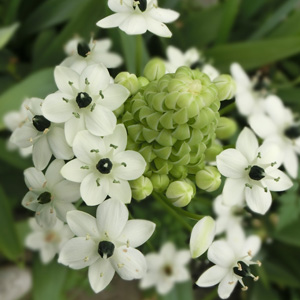Black Pearl Lily Growing Guide

What is Black Pearl Lily?
The black pearl lily (Ornithogalum arabicum) also known as Arabs Eye, Arabian Star is a bulbous perennial. They are from the Liliaceae family and originated from the Mediterranean. Black pearl lilys are well known for their ‘black pearl’ in the center of their flowers. Each flower has multiple stems that produces many lightly fragrant cream/white cups with black pea-sized centers. They flower in late Spring. Black pearl lily have blue green semi erect strappy leaves and the plant is frost hardy.
Benefits of Growing Black Pearl Lily
Black pearl lily make very long lasting cut flowers that are highly sought after by florists and flower arrangers due to their long stems and number of flowers per stem.
They are ideal for pots and containers or planted en masse as these little beauties waft their beautify scent. They will slowly multiply in numbers and form larger clumps.
How to Grow Black Pearl Lily
Climatic Zones
Suitable for all climates except tropical.
Plant Size
Height: 40-50cm, Width: 10-20cm
When To Plant Black Pearl Lily
Plant in Autumn.
Soil Preparation
They like well drained soil. Before planting work through well broken down animal manure or compost and top dress with a complete fertiliser.
How To Plant Black Pearl Lily
Plant in full sun to part shade, 15cm apart with the bulb at a depth of 8 cm.
Black Pearl Lily Plant Care
Watering is only necessary if soil begins to dry due to insufficient rainfall as they like moist soil when growing.
Bulbs can be left undisturbed for many years. If digging is required wait until flowers have died down. Larger clumps can be divided. Keep the bulbs in a cool dry place and replant in Autumn.
No real concern from pests. Just watch for snails and slugs around the new growth.







